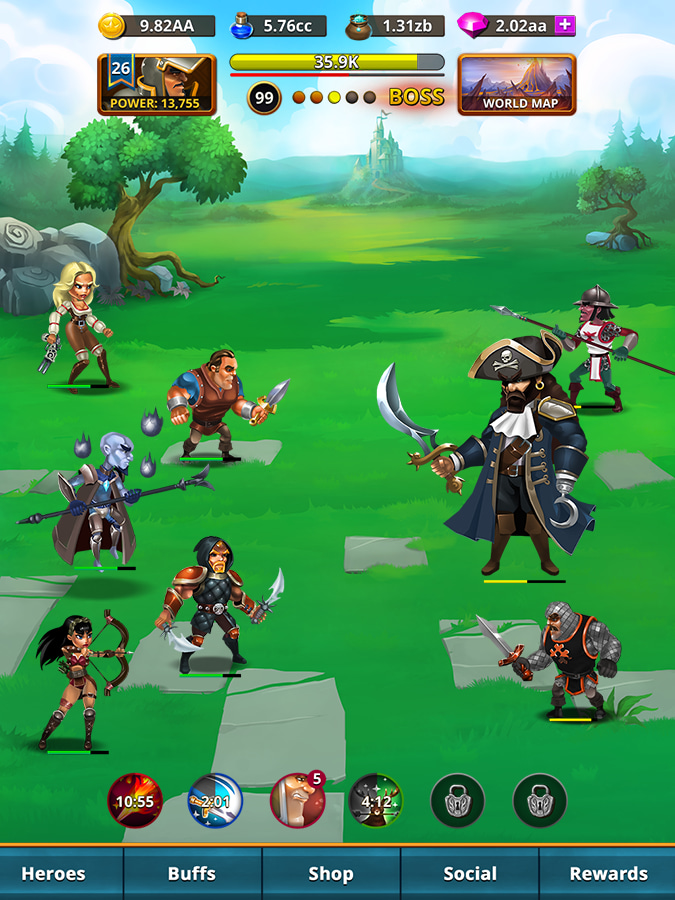Do you want your mobile game to capture your target audience’s attention and rank as a top game in the app store?
The key to making this happen is a well thought-out mobile game marketing strategy.
The mobile game market is fiercely competitive – marketers and game developers who want to stand out must leverage the right tools and techniques.
At PickFu, we’ve helped mobile gaming brands make data-backed marketing decisions. In this article, we bring 16 years of consumer research experience to help you improve your mobile game marketing efforts.
Keep reading to market your game more effectively and make it a must-have download.
Why is marketing your mobile game important?
The phrase “Build a better mousetrap, and the world will beat a path to your door” does not apply in the modern-day gaming world.
You could create the best mobile game ever – but you won’t get any users without marketing.
We’re probably preaching to the choir since you’re already here reading this post. But just in case, here are a few critical reasons you should strategically promote your mobile game app:
- Ensure that your target gamers find your game. Becoming more visible is the first step toward finding gamers and building a strong user base.
- Marketing is necessary to draw players in and provide compelling reasons for them to stay. Strategies like implementing a soft launch to reach a limited audience before a full-scale rollout are great for marketing your game early in the process. You’ll get data on player behavior and can iron out bugs to boost user retention.
- Marketing opens up monetization opportunities. You earn more through in-app purchases, advertisements, or in-game advertising when you get more users.
- A strong marketing strategy can generate buzz on social media through contests and other campaigns. You create the opportunity to make your game go viral.
Marketing your mobile game isn’t just about promoting your product; it’s about crafting an engaging experience your players will love, discuss, and return to.
Let’s dive into how you can build a great mobile game marketing strategy!
How to create an effective mobile game marketing plan
You’ve done the first step: understanding the importance of a solid marketing strategy.
Now, let’s explore how to actually build one. This requires knowing your audience, promoting your game to them, and fostering deep connections because gaming is a community-oriented industry.
1. Understand your audience

There are many different types of gamers: casual gamers, social gamers, strategy players, role-playing gamers, and more.
Targeting all players isn’t enough when marketing your game. If your game or marketing is for everyone, then it’s really for no one.
That’s why you need to understand your specific audience thoroughly to launch app marketing that works. Here’s how:
- Use app market research tools: The first step is to pinpoint the demographics of your ideal players. Research tools like Firebase and app store analytics are helpful for diving into age, gender, gaming preferences, and even devices used when gaming.
- Analyze player behavior and preferences: Listen to what your target audience is saying on social media and forums dedicated to video game enthusiasts. Platforms like Reddit and Feedspot can offer unfiltered insights into what players love, hate, and wish for in a game.
- Use PickFu to validate and expand on your research: Your app market research will uncover a bunch of data that could leave you feeling more lost than ever. PickFu can help you hone in on your gamer persona, and what they’re looking for, through online focus groups. We’ll explore this more later.
With research and testing, you’ll build an information base to inform your marketing decisions. Research is also important for app development (iOS or Android), proof of concept testing, and prototype testing. When you test from the earliest stages of your process, you can make decisions that save the most money and create the best outcomes.
2. Leverage app store optimization (ASO)
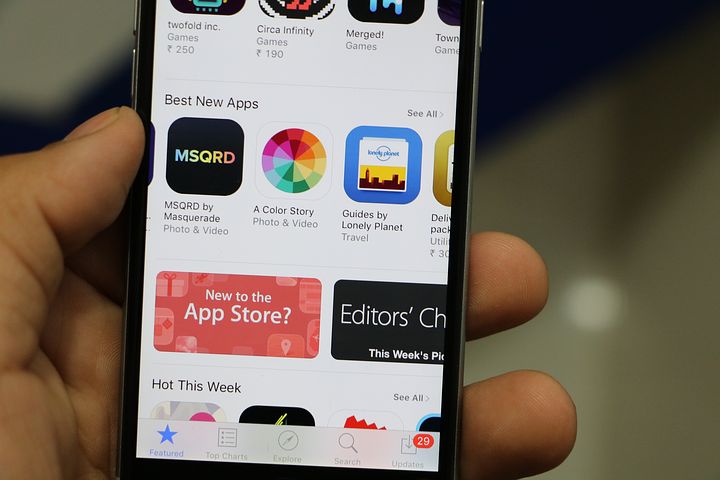
App store optimization (ASO) is the process of boosting your game’s visibility in app store search results – helping you rank higher to make it easier for people to find your game. It’s essentially app store SEO.
Here are steps to optimizing your app listing so players can discover your game through search:
- Carefully research and identify keywords your game users might search for. Include these terms in your mobile game app title and description.
- Create eye-catching app icons and engaging screenshots. These elements must draw users’ attention as gamers scroll through a mobile app store.
- Run feedback collection campaigns to encourage players to leave positive reviews and ratings. You can do this with push notifications or survey emails. The more ratings you have, the more likely it is that your app will show up organically as a top result.
However, simply following best practices doesn’t always lead to actual results, such as more downloads. You need to run tests and get user feedback to confirm that your efforts are working.
You can do this through live A/B testing in the App Store (show two versions of your listing to see which one performs best) – however, it can be time-consuming to wait for enough data, and in the meantime, half of the users will see a worse-performing version.
This is where PickFu really shines. It helps mobile game developers A/B test their app icons, screenshots, and descriptions before they even launch on the app store – as well as gather valuable written feedback you won’t get from regular A/B testing. You’ll not only understand which version will likely perform better but why. Mojiworks did this kind of testing with its mobile game, Ready Chef Go!
3. Create compelling visual assets

You must showcase creativity and functionality in video ads, social media images, and other visual assets to tell your game’s story. Here’s how imagery boosts your marketing:
- Design captivating trailers and gameplay teasers: A well-crafted gameplay teaser can showcase unique gaming experiences awaiting players. Focus on your storyline and unique mechanics as a call to action to drive more downloads.
- Leverage social media platforms: YouTube, TikTok, and other networks provide great opportunities for engaging with potential players. Post eye-catching screenshots, concept art, and behind-the-scenes looks into the game development process. This way, you can build anticipation and foster a community around your game.
- Share visual assets consistently: You should regularly update your social media channels, website, and app store listing with fresh visuals to keep your game top-of-mind for potential players.
Here’s an example of how a PickFu test helped a mobile gaming brand pick the right screenshot to attract more players.
4. Take advantage of content marketing
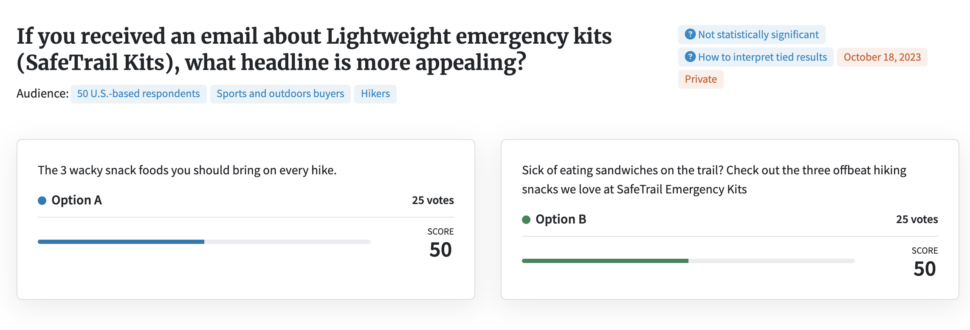
A content marketing strategy will help you attract and engage your audience, as well as establish your game’s brand and reputation.
Everyone’s content marketing strategy looks different and is unique to their brand, and content isn’t limited to blog posts, so keep that in mind.
Here are a few tips for harnessing content for your mobile game marketing campaigns:
- Create regular blog updates: Check out Nintendo Life, where the Japanese brand features gaming news, reviews, and talking points to drive discussions. Similarly, you can provide game updates via your blog to keep your audience engaged and informed.
- Leverage SEO: Search engine optimization (SEO) makes your website or YouTube video content discoverable. Add targeted keywords relevant to your game to help your content rank higher in search engine results.
- Form partnerships: Expand your reach using content collaborations with other gaming websites, brands, and content creators. Guest posts, co-created content, and cross-promotion initiatives will help expose your game to a broader audience.
Make sure you build a content calendar and keep sharing news and other information to get more traffic and build online authority as a reputable gaming company.
5. Use paid ads and performance marketing tactics

The truth is that most mobile game apps will need to invest in ads to drive initial engagement and traffic. This is especially the case if you’re an indie developer.
One strategy is to tap into ad networks – especially Unity Ads, which focuses on mobile games and has top retention rates. Also, use playable ads to stand out in an eye-catching ad format and give people a sneak peek into your gameplay.
Monitor your ad performance and update your text and visuals often to increase downloads, clicks, and app purchases.
Real-life advertising is expensive, and one way to ensure you get a return on investment is to test your ads with PickFu. Run a quick poll for under $100 to see how real gamers respond to your visuals and texts before spending thousands of dollars on ads that may not work.
The ads have only two differences: they have different icons, and Option A uses the keyword “brain teaser” in the title to make it more descriptive.
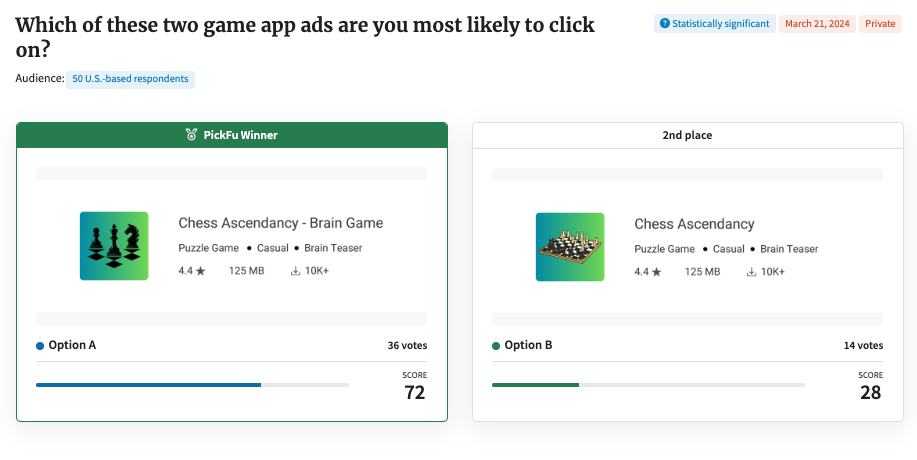
There’s a clear winner: Option A! The respondents said the simple icon and the keyword played key roles in their decision. You can explore the individual responses, demographic reports, and AI highlights for more detail.

Running a poll like this costs under $80 and tells you what works in about an hour – while running an A/B test with live ads is far more expensive and can take weeks to get results.
5. Engage with influencers and gaming communities
Community stands as an essential pillar in the mobile gaming industry. And if you want to connect with gamers fast, you need to tap into influencer marketing.
Here’s how to effectively work with the right influencers to get more users:
- Identify relevant influencers: Pinpoint influencers who resonate with your game’s genre and values. Tools like JoinBrands and Collabstr make finding and connecting with relevant influencers easier.
- Collaborate for sponsored content and reviews: Partner with influencers to create sponsored content, gameplay reviews, or live streams. You get added credibility through the influencer’s endorsement.
- Participate in gaming forums: Engage directly with gaming enthusiasts by participating in online forums and communities. Answer questions and provide tips. This grassroots approach helps build genuine relationships and pique interest in your game.
- Host contests, giveaways, and events: One of the best ways to engage gamers is to run contests, giveaways, and in-game events to drive engagement and reward your community. These activities encourage player participation and spread word of mouth.
- Reward loyalty: Reward users who stay with a loyalty program or setup where they get bonus gaming money or badges the long they are on your app.
You can create the most impact by distributing your influencer collaboration efforts across as many marketing channels as possible. Make sure you take a community-centric approach to appeal to your audience.
6. Analyze data to iterate on your strategy
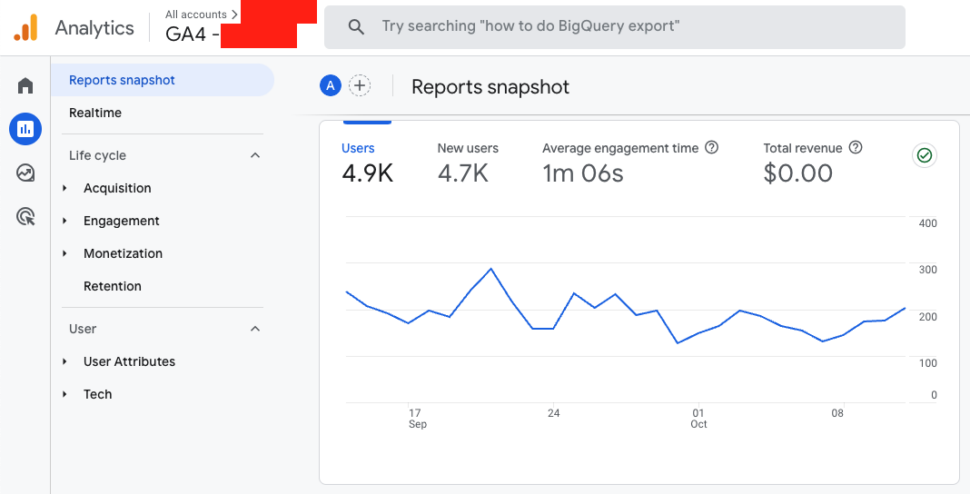
Every marketing strategy needs continuous data and feedback. If you don’t know what’s working, how will you improve it?
Start by tracking important metrics through app analytics. Apple’s App Store and Google Play Store will give you data on user acquisition trends, engagement, and retention rates, which is especially useful after you launch a marketing campaign. You should always monitor these metrics to ensure nothing is way off-track.
From there, you should gather consumer insights and direct feedback. Keep an eye on your app store reviews from the people who have played your game – what are they saying and what can you improve?
For your target audience of potential gamers, you can run quick tests with PickFu to get gamers’ feedback on updates, new designs, and campaigns to inform the direction you should take next.
And if you want to boost localization and adapt your game to different countries, languages, and cultures? PickFu has respondents from eight countries (and growing) to help you test your game with players across the globe.
Finally, make changes to your strategy based on game analytics data and feedback. This can range from adjusting your game’s features to revising your paid ad campaigns. Your goal is to keep players loyal and drive revenue, so adjust your marketing to support these goals.
Don’t look for a final solution – allow your strategy to evolve with data. It’s how you make sure your game is relevant over time.
Key metrics to track in mobile game marketing
Ensuring your game’s success depends on monitoring important metrics. Revenue and number of players aren’t the only things that matter.
Here are other factors to learn more about player behavior, loyalty, and your app’s potential success:
- Conversion rate: This measures how well your promotions get viewers to take action. The higher the conversion rate, the better your app and marketing are doing. Conversions could refer to how many apps are installed, discount codes activated, or how many signed up on your email list.
- Downloads: This is the total number of times your game has been downloaded. It gives a basic indicator of your game’s reach and initial interest among potential players.
- Logins: Tracking daily or monthly active users through logins gives a clear picture of user engagement and your game’s ability to retain interest over time.
- User acquisition cost (UAC): This metric calculates the cost linked to getting new users. It informs you if your marketing efforts are working.
- Retention rate: This is a very important metric for mobile game marketing. A retention rate shows how many players continue to play the game after their initial download. It gives a picture of your game’s long-term viability.
- Average revenue per user (ARPU): This financial metric indicates the average income generated per active user. You’ll learn about your game’s profitability and whether your monetization strategies are effective.
- In-app engagement metrics: Session length and the number of sessions per user are some engagement KPIs that indicate how engaging your game is. These metrics reveal which features or content keep your users interested.
- Churn rate: This tracks how many users stop playing the game over a certain period. It signals potential issues with game features, difficulty, or player satisfaction.
Monitoring these metrics (and others) closely so you can fine-tune your marketing strategy and ensure the financial success of your mobile game.
Optimize your mobile game marketing with consumer insights
Whether you’re a game publisher, mobile game designer, or marketer, you need to continuously evolve your mobile game marketing strategy based on user feedback and data.
That’s why one of the most important tools for leveraging your ad spend effectively and bolstering your marketing efforts is a user testing and consumer feedback tool.
With a visual medium like games, slight variations in color, imagery, and design can mean the difference between success and failure.
To make data-driven decisions at every stage, run A/B tests and surveys with PickFu. Just sign up for an account and launch a poll in a few clicks. Within a couple hours, you’ll get audience preferences on your app store icons, character designs, ad creative, and much more.
Sign up for free to start testing your mobile game marketing!
FAQs
How to optimize mobile game marketing campaigns?
You can optimize every aspect of mobile game marketing with user testing. If you’re thinking, ‘I have an idea for an app,’ – use PickFu polls to test if your mobile game is feasible. You can use PickFu as a name test app to pick an attractive name. Validate your marketing efforts with user feedback.
How to measure the success of a mobile game marketing campaign?
There are many ways to measure the success of your mobile game marketing: track the number of app installs, in-app purchases, logins, and retention rate. You can also tell you’re successful if you get offers to sell your app idea.

